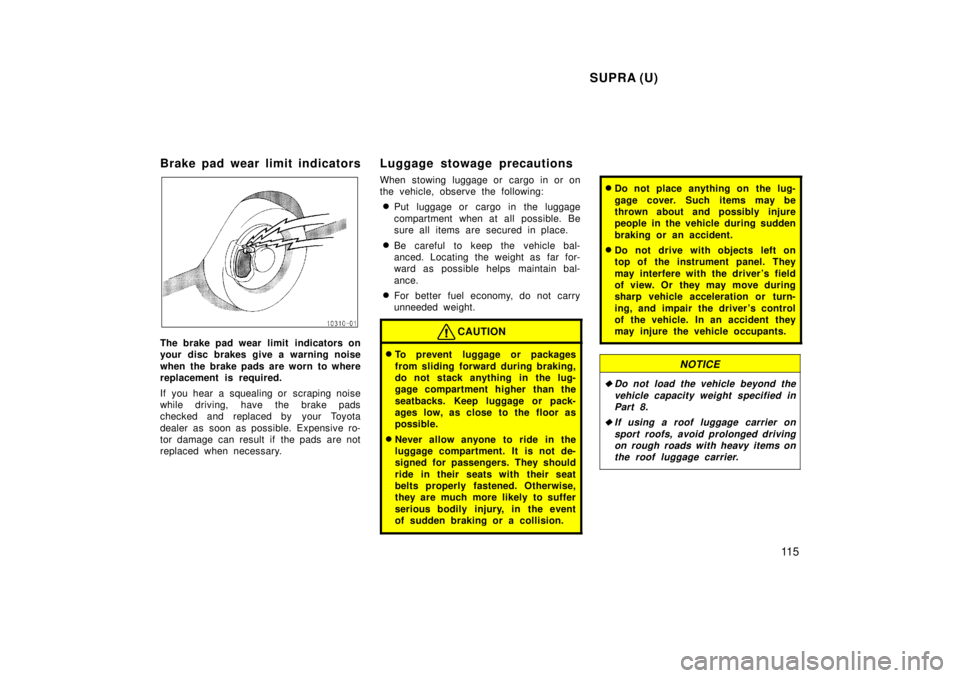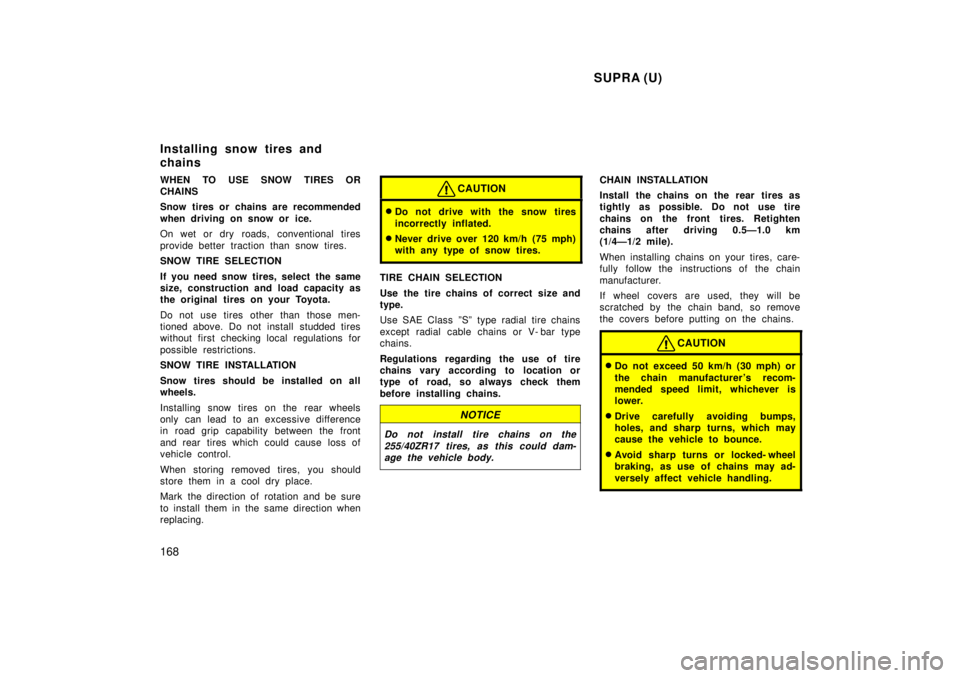1998 TOYOTA SUPRA load capacity
[x] Cancel search: load capacityPage 115 of 191

SUPRA (U)11 5
Brake pad wear limit indicators
The brake pad wear limit indicators on
your disc brakes give a warning noise
when the brake pads are worn to where
replacement is required.
If you hear a squealing or scraping noise
while driving, have the brake pads
checked and replaced by your Toyota
dealer as soon as possible. Expensive ro-
tor damage can result if the pads are not
replaced when necessary.
Luggage stowage pr
ecautions
When stowing luggage or cargo in or on
the vehicle, observe the following: � Put luggage or cargo in the luggage
compartment when at all possible. Be
sure all items are secured in place.
� Be careful to keep the vehicle bal-
anced. Locating the weight as far for-
ward as possible helps maintain bal-
ance.
� For better fuel economy, do not carry
unneeded weight.CAUTION
�To prevent luggage or packages
from sliding forward during braking,
do not stack anything in the lug-
gage compartment higher than the
seatbacks. Keep luggage or pack-
ages low, as close to the floor as
possible.
� Never allow anyone to ride in the
luggage compartment. It is not de-
signed for passengers. They should
ride in their seats with their seat
belts properly fastened. Otherwise,
they are much more likely to suffer
serious bodily injury, in the event
of sudden braking or a co llision.
�Do not place anything on the lug-
gage cover. Such items may be
thrown about and possibly injure
people in the vehicle during sudden
braking or an accident.
� Do not drive with objects left on
top of the instrument panel. They
may interfere with the driver's field
of view. Or they may move during
sharp vehicle acceleration or turn-
ing, and impair the driver's control
of the vehicle. In an accident they
may injure the vehicle occupants.
NOTICE
�Do not load the vehicle beyond the
vehicle capacity weight specified inPart 8.
�If using a roof luggage carrier on
sport roofs, avoid prolonged drivingon rough roads with heavy items onthe roof luggage carrier.
Page 116 of 191

SUPRA (U)
11 6
Limited- slip differential
Some Toyotas are equipped with a lim-
ited- slip differential. If one rear wheel be-
gins to spin, the limited- slip differential is
designed to aid traction by automatically
transmitting driving force to the other rear
wheel. If you are not sure whether your
vehicle is equipped with one, you can ask
your Toyota dealer.
CAUTION
Do not start or run the engine while
your vehicle is supported by a jack.
The vehicle could be driven off the
jack and could pose a danger or re-
sult in serious injury.
NOTICE
Use only a spare tire of the same
size, construction and load capacityas the original tires on your Toyotabecause damage to the limited- slip
differential could possibly occur withanother tire type.
Your Toyota's identification
The vehicle identification number (VIN)
is the legal identifier for your vehicle.
This number is on the left top of the
instrument panel, and can be seen
through the windshield from outside.
The vehicle identification number (VIN) is
also on the Certification Label.
This is the primary identification number
for your Toyota. It is used in registering
the ownership of your vehicle.
Page 166 of 191

SUPRA (U)167
This also applies to the spare tire and
tires stored for future use.
REPLACING YOUR TIRES
When replacing a tire, use only the
same size and construction as original-
ly installed and with the same or great-
er load capacity.
Using any other size or type of tire may
seriously affect handling, ride, speedome-
ter/odometer calibration, ground clearance,
and clearance between the body and tires
or snow chains.
CAUTION
�
Do not mix radial, bias belted, or
bias- ply tires on your vehicle. It
can cause dangerous handling char-
acteristics, resulting in loss of con-
trol.
� Do not use tires or wheels other
than the manufacturer 's recom-
mended size.
Toyota recommends all four tires, or at
least both of the front or rear tires be
replaced at a time as a set.
See ºIf you have a flat tireº in Part 4 for
tire change procedure. When a tire is replaced, the wheel
should always be balanced.
An unbalanced wheel may affect vehicle
handling and tire life. Wheels can get out
of balance with regular use and should
therefore be balanced occasionally.
When replacing a tubeless tire, the air
valve should also be replaced with a
new one.
Rotating tires
70030F08
Do not perform rotation of the tires,
from front to rear or from left to right,
or using the compact spare tire. Per-
forming such tire rotation may result in
the tires interfering with the body or in
uneven wear of the tires, so that steer-
ability of the vehicle is impaired.
Tires with turning direction indicatorÐ
The tire is a uni- directional type and can-
not be used for tire rotation. Using the tire
on the opposite side to the designated
side will impair the tire performance.
The compact spare tireÐ
The tire is designed for temporary use
only and cannot be used for tire rotation.
Page 167 of 191

SUPRA (U)
168
WHEN TO USE SNOW TIRES OR
CHAINS
Snow tires or chains are recommended
when driving on snow or ice.
On wet or dry roads, conventional tires
provide better traction than snow tires.
SNOW TIRE SELECTION
If you need snow tires, select the same
size, construction and load capacity as
the original tires on your Toyota.
Do not use tires other than those men-
tioned above. Do not install studded tires
without first checking local regulations for
possible restrictions.
SNOW TIRE INSTALLATION
Snow tires should be installed on all
wheels.
Installing snow tires on the rear w
heels
only can lead to an excessive difference
in road grip capab ility between the front
and rear tires which could cause loss of
vehicle control.
When storing removed tires, you should
store them in a cool dry place.
Mark the direction of rotation and be sure
to install them in the same direction when
replacing.
CAUTION
� Do not drive with the snow tires
incorrectly inflated.
� Never drive over 120 km/h (75 mph)
with any type of snow tires.
TIRE CHAIN SELECTION
Use the tire chains of correct size and
type.
Use SAE Class ºSº type radial tire chains
except radial cable chains or V- bar type
chains.
Regulations regarding the use of tire
chains vary according to location or
type of road, so always check them
before installing chains.
NOTICE
Do not install tire chains on the
255/40ZR17 tires, as this could dam-age the vehicle body.
CHAIN INSTALLATION
Install the chains on the rear tires as
tightly as possible. Do not use tire
chains on the front tires. Retighten
chains after driving 0.5Ð1.0 km
(1/4Ð1/2 mile).
When installing chains on your tires, care-
fully follow the instructions of the chain
manufacturer.
If wheel covers are used, they will be
scratched by the chain band, so remove
the covers before putting on the chains.
CAUTION
� Do not exceed 50 km/h (30 mph) or
the chain manufacturer 's recom-
mended speed limit, whichever is
lower.
� Drive carefully avoiding bumps,
holes, and sharp turns, which may
cause the vehicle to bounce.
� Avoid sharp turns or locked- wheel
braking, as use of chains may ad-
versely affect vehicle handling.
Installing snow tires and
chains